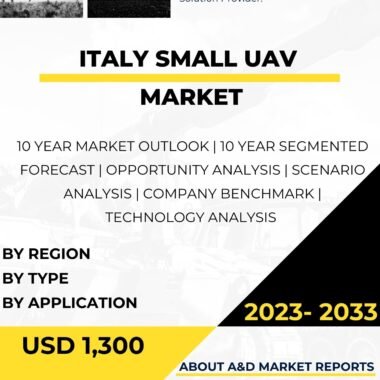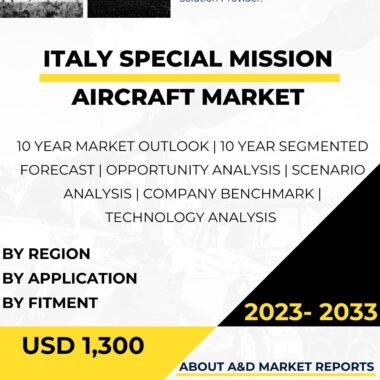Description
United Kingdom Airborne ISR Market
Airborne Intelligence, Surveillance, and Reconnaissance (ISR) systems have become indispensable assets for modern militaries, enabling real-time data collection, analysis, and decision-making. The United Kingdom airborne ISR market plays a pivotal role in enhancing the country’s military capabilities, providing critical intelligence and situational awareness for defense operations. This article examines the current state of the UK airborne ISR market, its applications, key players, challenges, and future growth prospects.
Airborne ISR involves the use of manned and unmanned platforms equipped with a suite of sensors, cameras, and communication systems to collect and relay valuable information. These platforms can operate at various altitudes and ranges, providing intelligence on enemy activities, geographical features, weather conditions, and other crucial data. The data collected by airborne ISR systems aids in planning, decision-making, and coordination of military operations.
The United Kingdom’s defense establishment places a strong emphasis on airborne ISR capabilities to enhance its situational awareness and intelligence-gathering capabilities. ISR assets are instrumental in supporting a wide range of missions, including reconnaissance, surveillance, target acquisition, border security, and search and rescue operations.
One of the primary applications of airborne ISR in the UK is supporting military operations. Manned aircraft, such as the E-3D Sentry and RC-135 Rivet Joint, and unmanned aerial vehicles (UAVs) like the MQ-9 Reaper, play critical roles in providing real-time intelligence to military commanders. These platforms are equipped with advanced sensors, radars, and communication systems that enable them to monitor large areas and relay data to ground stations in real-time.
In addition to military applications, airborne ISR is valuable for civilian purposes, including border surveillance, disaster response, and environmental monitoring. UAVs equipped with high-resolution cameras and infrared sensors are used for border patrol and search and rescue missions, providing valuable assistance to law enforcement and emergency response agencies.
The UK airborne ISR market comprises a mix of domestic defense companies and international players. British firms have made significant contributions to the development and integration of ISR systems into military and civilian platforms. Collaborations with international partners enable knowledge exchange and foster innovation in airborne ISR technologies.
Challenges in the UK airborne ISR market include addressing the complexity of integrating multiple sensors and data sources into a coherent and actionable intelligence picture. Data management, fusion, and analysis are critical components of effective ISR operations. Ensuring interoperability between different platforms and data sharing systems is crucial for optimizing ISR capabilities.
The UK’s airborne ISR market also faces budgetary constraints and cost considerations. Developing and maintaining advanced ISR capabilities require substantial financial investments. Striking a balance between budget limitations and maintaining cutting-edge capabilities is a continual challenge for defense planners.
Moreover, the UK must adapt to emerging threats and technological advancements to remain at the forefront of airborne ISR. Potential adversaries continuously develop countermeasures to disrupt ISR operations. The defense industry must invest in research and development to stay ahead of these threats and ensure ISR effectiveness.
Looking ahead, the future prospects of the UK airborne ISR market are promising. Advancements in sensor technologies, artificial intelligence, and data analytics will enhance the capabilities of airborne ISR platforms. These advancements will enable more precise and real-time data collection, processing, and dissemination, improving the effectiveness of ISR operations.
Furthermore, the integration of unmanned systems into airborne ISR operations is expected to play a significant role in the market’s growth. UAVs offer the advantages of extended endurance, reduced operational costs, and the ability to access areas that may be challenging for manned platforms. As UAV technologies continue to evolve, they will play an increasingly crucial role in ISR missions.
International collaborations and joint development programs will continue to shape the UK airborne ISR market. Partnering with technologically advanced nations allows the UK to share expertise, access cutting-edge technologies, and strengthen ISR capabilities collectively.
In conclusion, the United Kingdom’s airborne ISR market is a vital component of its defense industry, providing essential intelligence and situational awareness for military and civilian purposes. ISR capabilities are instrumental in supporting a wide range of missions, from military operations to border surveillance and disaster response. Addressing challenges related to data integration, budget constraints, and emerging threats requires continuous investment in research, innovation, and collaboration with international partners. Looking forward, advancements in sensor technologies and international cooperation will play a pivotal role in shaping the future of the UK airborne ISR market, enhancing the nation’s intelligence capabilities and contributing to its overall security posture.




